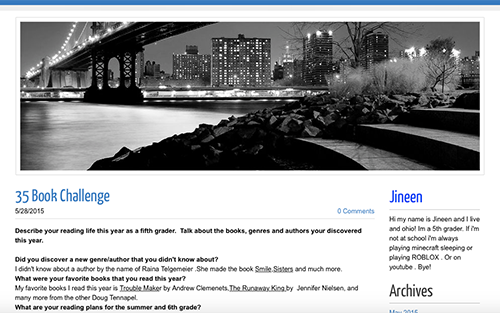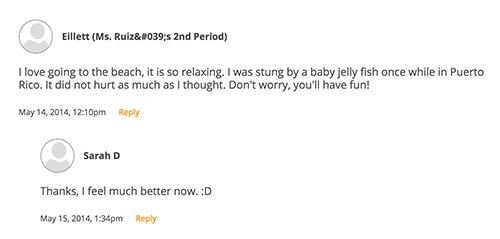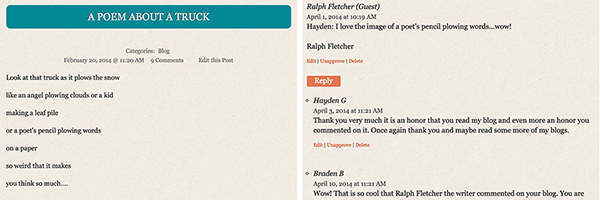Chapter 7: Cultivating Student Ownership with Audience, Autonomy, Discourse and Reflection
7.2 Essential #1: Audience: Motivation for Students’ Creations

Audience matters. That is one important concept for young writers to keep in mind as they develop writing pieces. In my pre-digital classroom, my students wrote primarily for their classmates and me. Students knew the teacher was usually the only one who was going to see their work, coupled with sharing their drafts with their peer editors and classmates. Now that I look back, I recognize that in my pre-digital classroom, audience didn’t matter. That is to say, some students lacked the motivation to create writing pieces because the audience never changed. Audience motivates my students by providing them with real-world opportunities for their writing and other digital work to reach outside the classroom.
One day a group of students were blogging during a writing workshop. One of them announced to the class, “Mr. Jones, some girl from Texas just left a comment on my blog.” I looked at her blog post with skepticism, and sure enough, there was a comment from a 10th grade student from Austin, Texas. One by one, other students noticed that they had also received comments from 10th graders in Austin, Texas. After a few days of research, I narrowed down these students’ teacher and school. I sent an email thanking her for providing an authentic audience to my fifth graders. I wanted her to know that she and her students had given my students a powerful message about audience. Many of the comments, such as the examples here, gave students the enthusiasm and initiative to keep writing. These comments were specific to each blog post, and often times asked follow up questions related to the writing. This indicated to my students that this new audience of high schoolers were actually reading the blog posts. They noticed that the comments were meant for the individual blogger. Each new comment became a powerful celebration of our writing and energized my students.


Pretty soon, these young writers in my classroom would voluntarily ask to login to their blogs and see if someone replied to one of their posts. Yet, something else began to happen. Students were starting to bring their audience into their peer conversations about their writing. I could hear students saying things like, “Well, Antonio from Texas said that he liked my first sentence, so I want to keep it.” Furthermore, I noticed that the quality of their writing improved. Students were spending more time editing for grammar, punctuation and spelling mistakes. Despite regular reminders from me about writing mechanics, my students found a new sense of motivation as a result of their new audience. This authentic audience from 1,200 miles away truly heightened my students’ motivation, hence their sense of ownership was growing.
Another example comes from a student, Hayden, inspired by the poetry of Ralph Fletcher, wrote a poem about a snowplow plowing our school playground. (Yes, he had been looking out the window daydreaming during independent work time, but, boy, did it inspire a magnificent poem from this 10-year old.) When I conferred with him about this, I made sure he knew I was blown away by his figurative language. He ended our conference by asking me to tweet out the link to his blog. Hayden was actually seeking out an audience beyond our classroom walls. He was both surprised and thrilled when after a month, Ralph Fletcher himself replied to his blog. Ralph Fletcher’s reply helped my students realize that their work was being seen outside our classroom walls and it motivated them to write even more.

Digital Portfolios – Curating Learning For A Global Audience
Throughout the school year, my students curate pieces of quality work and artifacts that demonstrate their learning. In the past, before I recognized my students as digital citizens, I gave students back their graded work and assessments, and they would go through the process of inserting this work into a 3-ring binder and filling out a reflection paper that I provided them. The purpose of these data binders was to require students to be more mindful of their development as a learner by reflecting on their work. However, there was one glaring issue with this process. The binders stayed on a shelf in our classroom. These binders had an audience of one. The student was truly the only person who saw the contents of this binder. As I learned to push my students to be contributors to the digital world, I started to wonder what would happen if students’ work and reflection process was communicated to the digital world. Therefore, I decided to shift these binders into digital galleries of student learning called digital portfolios.
In my classroom, a digital portfolio has become a digital and public collection of a student’s learning journey. It is a space where students tell their story–document current understanding, celebrate successes, show their progress, store finished products, and reflect on their growth from pre- to post-assessments and demonstrate their reading and writing lives. By digitizing their portfolios, students would be displaying their learning journey for all to see. No longer would their portfolios be in a 3-ring binder stored on a shelf in the classroom, only to be opened when they receive a math test back. Now, each student’s learning process would be on display beyond the classroom walls, in addition to being more easily exhibited for their classmates and other stakeholders (e.g. parents, extended family, former teachers, peers).
Not only do digital portfolios offer a wider audience for students to display their work, they are also powerful tools because they allow students to make digital contributions to the digital world that incorporate audience, autonomy, feedback and reflection. In each of the following sections, I will show how digital portfolios support each of these essentials of digital experiences.
Classroom Implications
Our unplanned pen-pals from Texas and a comment from Ralph Fletcher are wonderful examples of students writing for an audience outside of the classroom. Also, digital portfolios are an example of creating a public gallery of learning that is meant for a larger audience than merely the student and teacher. So, what were the effects of creating a larger audience for student work? How did this change my students’ growth as learners?
There were a number of positive outcomes that resulted from this shift in audience. One result was students were more engaged with the work, propelled by the idea that their writing pieces and quality work samples are expected by an audience beyond the school. Secondly, as bloggers, students began to think of their audience during their writing process and make deliberate writing decisions based on the idea that anyone could read their writing. Audience wasn’t an afterthought once they published their work. Thirdly, writing with an audience in mind became part of our daily conversations during our reading and writing workshops. For example, during our interactive read alouds, students began to make connections between authors’ writing decisions and how it affected the reader. Lastly, using digital portfolios to make their work samples public and share their reflections as a learner gave my students a deeper purpose for learning and producing high quality work.
While some students are intrinsically motivated to write because it is a passion, what was truly motivating was the thought of someone out in the world reading their writing. Students were inspired when they were offered an audience with whom they genuinely wanted to connect.